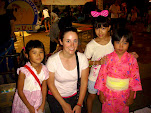My midweek holiday brought true meaning to the Culture Day Holiday. Back in October, a teacher at the largest ES asked me if I wanted to attend a tea ceremony. Well, of course I said yes, so at 9:30am (Wed. 11/3), this wonderful lady, her husband, and I set off to a neighboring town about 30 minutes west of Mitake. I can’t tell you how busy it was, there was quite a crowd on this small road. The reason was that once a year, the area opens up homes along the Nakasendo Road (I’ve blogged about this before) to the public. Wednesday was a 3-part event, part meal, part museum, and part tea ceremony.
First, we sat down on some benches in a newly built tea hall and we were served green tea and a small pastry. This wasn’t the normal green tea, this was usucha, which uses the best kind of green tea leaves and it is much more frothy than normal green tea. The pastry resembled a small slice of brownie, think rectangle, with brown (sweet beans), red, and yellow cake(all autumn colors, obviously). After we ate, we went and saw this temple outside. I really don’t know much about it, but I’m still amazed at the detail that each temple has. This is something we aren’t privileged to in the US, and I’m definitely going to miss the architecture and designs of temples, shrines, and houses for that matter, when I leave here.
After the outside temple, we made our way to the meal portion of the event. There was a little wait, so we walked around this old house converted into a museum. It was quite interesting, how houses were built some time ago and how they closely resemble what newer houses look like. The best part was the wiring of the house (I can tell you that if you are interested in electrical wiring, check out an older Japanese house…I can think of a few people who would’ve looked at it with amazement, hint: Dad). Lunch was very traditional, and I’m regretting the fact that I didn’t take a picture. It consisted of, tea, soup, rice, and small pieces of the following: salmon, egg, duck, chicken, chestnut, daikon, mushroom, carrots, tofu (deep fried…yum), a potato/almond concoction (delicious, my favorite), mint mixed with mashed tofu (weird), and finally more fish and shrimp mixtures I didn’t recognize. It was displayed beautifully, especially with how the vegetables were cut. For example, my slice of carrot looked like a flower, impressive. So after lunch, we went on the house tour. There were three houses, all lined up that had been built in different eras, by Japanese standards.
History note: In Japan, they say the year in terms of how long the current emperor has been in power. So, 2010 is Heisei 22. Or the 22nd year of Emperor Akihito’s rein. Heisei was picked because it meant “peace everywhere”. Before the Heisei period, it was Showa (1926-1989), Taisho (1912-1926), Meiji (1868-1912), and Edo (1603-1868). The Edo period was not based on Emperors, but rather on the Tokugawa Clan.
Back to the houses; each house was built in a different period, so Showa, Meiji, and Edo. Meaning they were fairly old (especially the Edo one). The lady that lived in the Meiji period house said that during the last large earthquake her house didn’t get very much damage, but the other houses suffered significant damage. I thought that was odd, until she pointed to the ceiling, and there was a huge piece of wood (actually, it was basically an entire length of a tree, support). And that’s when I understood why her house was okay; she had a massive wood beam supporting her house.
Finally, we went to an official tea ceremony. All the ladies were wearing kimonos and they looked so, professional. Luckily, the lady I went with used to practice the art of the tea ceremony, so she knew the ins-and-outs. That being said, she placed us in the perfect seating position. I was third from the right, meaning I was still one of the guests of honor (go me). That meant I got served third (out of 30) and I got my tea served in a special tea bowl. It was beautifully decorated and it really was a treat. About 25 minutes later the tea ceremony was over and I couldn’t feel my legs…yes, I had been sitting on my knees for 25 minutes, not an easy feat.
When we got back to the car, I thought we were going home because it had surprisingly been a long day already. Instead, she asked me if I’d like to see Inuyama Castle (in Japanese “inu”=dog and “yama”=mountain, so yes, Dog Mountain Castle, ha). It was a great day to see the castle because Culture Day also means it’s “Shichi-Go-San Day” or 7-5-3 Day. On this day, kids of the age 3, 5, or 7 dress up in full kid kimonos and basically get blessed for good luck growing up and everyone does it, so it was quite busy. We walked through the castle and the surrounding area and it was great because I got a better idea of the history of the castle because the lady could decipher the difficult kanji’s and then explain it to me in mostly Japanese, some English. After the visit to Inuyama Castle, we returned to Mitake about 7 hours later, so it was quite the day.
Inuyama Castle
The View From the Top of the Castle
Another View
Looking back on it, I would sat that culture day really lived up to its name on Wednesday. I learned a lot and I’m truly grateful for the people who’ve taken time out of their lives to show me Japan.










No comments:
Post a Comment